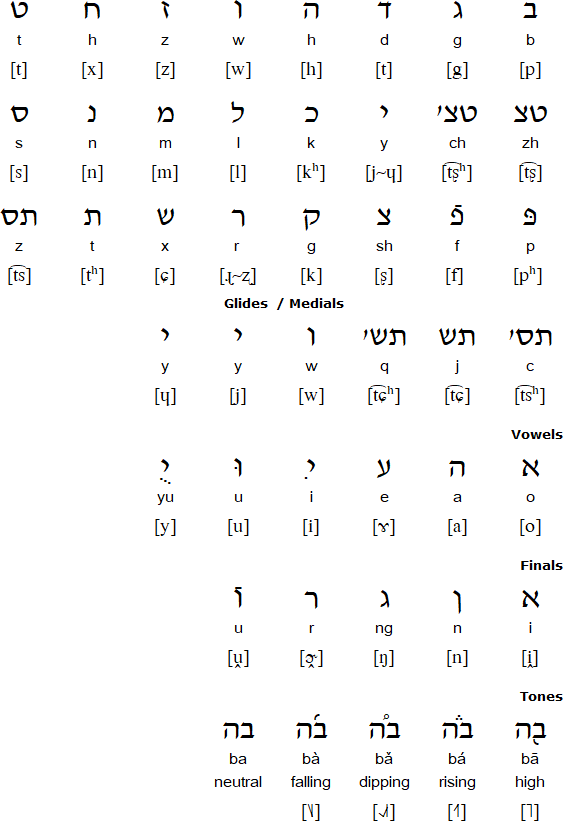
Tiāojīnjiào zhī wénzì is a way of writing Mandarin Chinese using the Hebrew alphabet devised by Isaac Mayer. It is also known as Judeo-Chinese.
Tiāojīnjiào zhī wénzì uses the Hebrew abjad as an alphabet. Because of the unique phonotactic structure of Mandarin Chinese, with a very limited number of nuclei and codas but a lot of onsets, it was possible to co-opt certain Hebrew letters to work as vowels instead of consonants, in a similar manner to the evolution of the Yiddish alphabetical system.
Chinese has three different kinds of sibilants - alveolar, retroflex, and palatal - and the Hebrew alphabet has three different sibilants as well. But since Chinese distinguishes between aspirated and unaspirated affricates, the old Hebrew chupchik mark ׳ was co-opted to distinguish the two. In general the Tiāojīnjiào zhī wénzì system tries to avoid an overuse of markings, so unaspirated front plosives are written as their voiced equivalents (just as in a standard pinyin system). The only exception was the velar plosive, since Hebrew has two unvoiced back plosives, and the voiced back plosive was necessary for a coda marker.
To mark tone, the Tiāojīnjiào zhī wénzì system took melodic cues from the Bukhori system of Biblical cantillation, as recorded by the great Jewish ethnomusicographer Abraham Tzvi Idelsohn.
Some “words” in Chinese use more than one syllable. In Tiāojīnjiào zhī wénzì these compounds are portrayed through the use of a Hebrew-script maqaf, used to link related words in a similar manner to the English hyphen. Punctuation-wise, the full stop is treated as a Hebrew sof-pasuk (׃ similar in appearance to a colon), and the comma is treated as a Hebrew period (.) . Other than that, Tiāojīnjiào zhī wénzì punctuation works similarly to standard Chinese punctuation - similar to standard European usage with a few additions (specifically,「 」mark quotations, and《 》mark titles).
There has been a Jewish community in Kaifeng in Henan in central China since at least the Northern Song Dynasty (960-1127 AD), and possibly since the Tang Dynasty (618-907 AD). The Jews of Kaifeng probably came from Persia or India originally, and arrived in China via the Silk Road. They built a synagogue in Kaifeng in 1163, which was destroyed in the 1860s, and the Kaifeng Jews eventually lost their traditions, apart from certain burial and dietary practices.
Today there are about 500 Jewish people in 100 families in Kaifeng, and about 1,000 peopole with Jewish ancestry. They are known as 挑筋教 (tiāojīnjiào) in Chinese.

Download an alphabet chart for Tiāojīnjiào zhī wénzì (Excel)

人人生而自由,在尊严和权利上一律平等。他们赋有理性和良心,并应以兄弟关系的精神互相对待。
All human beings are born free and equal in dignity and rights. They
are endowed with reason and conscience and should act towards one another
in a spirit of brotherhood.
(Article 1 of the Universal Declaration of Human Rights)
Information about Mandarin | Phrases | Numbers | Colours | Family words | Terms of endearment | Time | Weather | Tongue twisters | Tower of Babel | Articles | Links | Learning materials
Information about the Jews of Kaifeng
https://en.wikipedia.org/wiki/Kaifeng_Jews
Ajalaptlajkuilolistli, Čveneburuli / Judeo-Georgian, Grekoiberieraren Alfabeto Berria, Hágrít Nyelv, Inglith, iŋliʃ fidæl, nā hōʻailona ʻōlelo, Pikchukunap Qillqa, Ṣəḥəfätä Ǝsəraelawi, Tianjinjiao, Yahudi Türkçesi, Yūdu lipi
Constructed scripts for: Ainu | Arabic | Chinese languages | Dutch | English | Hawaiian | Hungarian | Japanese | Korean | Lingala | Malay & Indonesian | Persian | Tagalog / Filipino | Russian | Sanskrit | Spanish | Taino | Turkish | Vietnamese | Welsh | Other natural languages | Colour-based scripts | Tactile scripts | Phonetic/universal scripts | Constructed scripts for constructed languages | Adaptations of existing alphabets | Fictional alphabets | Magical alphabets | A-Z index | How to submit a constructed script
[top]
You can support this site by Buying Me A Coffee, and if you like what you see on this page, you can use the buttons below to share it with people you know.

If you like this site and find it useful, you can support it by making a donation via PayPal or Patreon, or by contributing in other ways. Omniglot is how I make my living.
Note: all links on this site to Amazon.com, Amazon.co.uk
and Amazon.fr
are affiliate links. This means I earn a commission if you click on any of them and buy something. So by clicking on these links you can help to support this site.
[top]